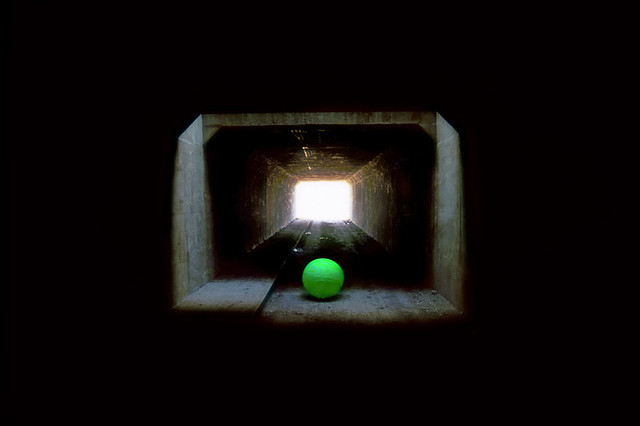''In the Middle East, new political concepts, initiatives and slogans are plenty, supplementing each other month after month as the previous ones exhaust themselves. In this part of the world, enduring abstract thinking tends to lose vision. But there is one reference that has borne a sustained potential for visualization, if not for political vision: the Green Line.
So many stones, or worse, have flown across this virtual line, which nobody has seen for years except for those who live within its confines. Nevertheless, everyone refers to it by name.
As I became tempted, like so many others, by a career as a messiah in this Holy Land, I decided to make the Green Line appear. Photography would be my magic wand. Later, as I was considering the various shades of green for my 12-meter long ribbon and painted balls to be placed in the landscape as an artificial allusion to the line, some people questioned my initial choice. “This is not the green of the Green Line”, they said, as if they had actually seen it for real !
The Green Line, it seems, is well enshrined in people’s minds, whether they like it or not, as a valid political reference. There are political concepts, like fashion trends, generated by continuously repeating assumptions until they become slogans.
This project wants to be a gentle, yet absurd, kick in the big green eyes of the so-called solution of “two States living side by side in peace and security along the 1967 border.” More interestingly, it is about showing the physical landscape of possible political separation, as was the case in the past, and about raising the understanding of the related issues at stake.
It is also about remembering the color of the line, trendy in all seasons, its artificial shape and vagueness in the various corners of the Land it reaches. It is about generating critical thinking and a healthy feeling of doubt to keep the door open to alternatives.
Since the Oslo years of the 1990s, the 1967 “border” has become the orthodox reference for negotiating the final contours of an improbable “viable” Palestinian State – or, as some would probably prefer, of a viable continued Israeli occupation. Consistently represented in green on a series of geographical maps, it has emerged as the Green Line, attributing also political and legal in/correctness to a series of issues, such as Israeli settlements.
Informed professionals and scholars would claim that the Green Line refers to the 1949 Rhodes armistice agreement between the newly established Israel and its neighboring Arab countries, reached in the absence of a peace treaty, not to the 1967 confrontation line showing the position of opposing forces before they went to war. Still, most people would probably assume that the 1949 line has remained the same till 1967. This overlooks the fact that the line has moved during this period. Its position has been continuously affected by the military and economic tactics of the parties and their desire to push the real “line” to the other side of the armistice “zone” where there was one, as is particularly the case in the Golan and near Latrun.
By looking today only at the little short-cuts taken by the legally contested separation Wall and fence around or behind the Line, not to mention its obvious deep intrusions into the West Bank in some areas, one could easily believe there had already been past attempts at pushing the limits !
Traveling during Spring and Summer along the line, it looks green indeed. Often, it also appears pale and blurred where there is a motorway interchange, a traffic intersection, inaccessible agricultural fields, empty hills or valleys, un-cleared minefields and military zones around the sections of wall and fence that make up the gently called "separation barrier". But its enduring political validity has been saturated by various, and sometimes contrary Israeli and Palestinian popular discourses.
The Line has its supporters and its opponents on both sides: from messianic religious Zionists claiming the eternal Jewishness of Judea & Samaria; to Palestinian radicals refusing to recognize Israel; to those contemplating some form of bi-nationalism, or Palestinian refugees who, hoping to return to homes that are today inside Israel, are afraid of borders; to nationalists and pragmatists ready to advocate the need for separation for different purposes. It is also contested by those who would like to define appropriate borders between populations and cultures, based on their location, rather than to accommodate existing legal frameworks.
For all these reasons, the Line is almost blinding because it is about cease-fire and hope, but it is also artificial and blurred. This is sometimes represented visually by the project, either by creating a movement effect, or by placing a virtual line in the landscape made of large green balls: the path between two points can indeed take an infinite number of courses, a straight line being only one of them.
This project simply intends to instrumentalise the visual nature of this political concept. By doing so, it intends to communicate, with a smile, a sense of absurdity when envisaging the likelihood of establishing borders in this landscape, if such a thing is possible at all.
Alban Biaussat - 2006''










No comments:
Post a Comment
Reply to message